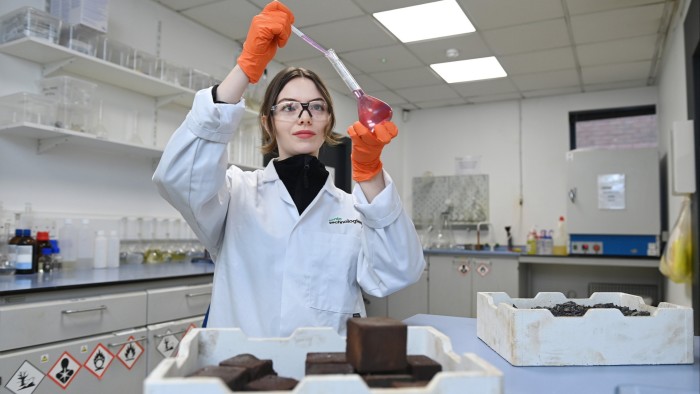President Donald Trump has designs on potential rare earth resources in Ukraine, the Democratic Republic of Congo and Greenland. But one company says it has developed a smarter way to access critical minerals needed for military drones, wind turbines and electric vehicles.
At a plant on Belfast Harbour in Northern Ireland, Ionic Technologies, a unit of Australian stock exchange-listed Ionic Rare Earths, has patented a method for extracting the four highest-value and most in-demand rare earth oxides from industrial magnets.
China dominates both rare earths mining and processing, and the market is valuable: Adamas Intelligence, a consultancy focused on supply chains for critical materials, predicts that the global value of rare earth oxides used to make magnets will grow more than fivefold to $44.1bn by 2040.
As a result, western efforts to obtain rare earths through recycling have intensified.
Companies such as Solvay in France, REEcycleinc in the US, Norway’s REEtec, HyProMag in the UK, Sweden’s LKAB and Germany’s Heraeus Remloy are seeking to extract rare earths from magnets, batteries, mining and other products, but Ionic says its process and ability to separate them set it apart in a “very niche” market.
The company, spun out from Queen’s University Belfast as Seren Technologies before being taken over by Ionic Rare Earths in 2022, is in talks to expand into the US, where Trump has made clear his aim to boost supplies of the minerals needed for advanced manufacturing and defence.
Ionic says that by relying on end-of-life magnets that are widely available, its approach reduces dependence on supplies from China and enables high purity production of the individual rare earth elements praseodymium, neodymium, terbium and dysprosium at commercial scale.
“Our USP [unique selling proposition] is that we’re the only company doing the separation . . . outside China,” said Tim Harrison, managing director of Ionic Rare Earths.
The Belfast plant expects to produce 400 tonnes per year of separated rare earth oxides with net revenue of $2.12bn over its 20-year lifespan, according to its feasibility study.
That was enough for approximately 2 gigawatts of wind turbines or about 200,000 EV motors, Harrison said.
Neha Mukherjee, rare earths senior analyst at Benchmark Mineral Intelligence, saw “many emerging players” but said Ionic had a “head start”.
Rare earths are not necessarily rare, despite their name, but competing with cheap Chinese processing is tough and pricing can be opaque.
Ionic Technologies has received £5mn in UK government grants. Julian Hetherington, director of automotive transformation at the UK’s Advanced Propulsion Centre, which delivered some of that funding, said the company’s “secret sauce” was its ability to separate in particular the heavy rare earth oxides — terbium and dysprosium — whose production in China has “flatlined” in recent years, and which are required to make magnets able to withstand high temperatures.
“There’s virtually no public domain IP on how you separate out the ‘heavies’ to a high degree of purity, it’s all really reserved in China . . . This is where Ionic do have a little bit of an advantage.”
Ionic is seeking a “cornerstone” investment from the UK’s Automotive Transformation Fund to move to commercial production in early 2027.
At its demonstration plant, individual rare earth elements from ground up magnets are extracted in giant 1,000-litre tanks and circuits before being passed through a kiln to produce oxides.
Under a partnership with Ford and UK alloy producer Less Common Metals — backed by a £1mn UK government grant — Ionic Technologies has a deal to supply elements for demonstration electric motors using entirely recycled rare earths by the end of 2025.
But Harrison said Ionic Technologies was also in “advanced talks” to expand across the Atlantic as Washington sought to secure supplies of rare earths essential for F-35 jets, submarines and drones.
“We are not far off being able to cement a footprint there,” said Harrison. The US Department of Energy had no immediate comment.
Ionic’s patented technology was replicable — plants could be up and running within two years, Harrison said, with the production process taking about 48 hours.
Average production costs at the Belfast plant are slightly less than $43 per kg. Market prices for the four oxides Ionic can extract range from about $62 per kg for neodymium oxide to almost $900 per kg for terbium oxide.
John Meyer, partner and head of research at brokers and advisers SP Angel said: “China produces everything so cheaply it’s very hard to undercut [them].” But using commonly available raw materials — magnets — offers security of supply “as long as you can get enough of them”.
Harrison said the four elements Ionic was focusing on made up more than 90 per cent of the rare earths’ market value. Dysprosium and terbium have the highest supply risk and the biggest potential industrial economic impact.
By 2030, the UK is forecast to consume up to 12 per cent of rare earths globally, according to the UK Critical Minerals Intelligence Centre.
Besides the US, Nato nations and others including Brazil, Japan and South Korea were seeking to diversify supply chains, Harrison said. “Any rare earth development outside China will require western government support,” to counter decades of Chinese investment in mining and processing, he said.
But by disrupting Beijing’s stranglehold “we can build multiple plants in the US or western markets,” Harrison added.
“It’s a very, very quick solution to an immediate problem.”
Read the full article here

